Largemouth bass offers a mild, slightly sweet flavor with white, flaky meat that’s surprisingly delicate and far less “fishy” than you’d expect. The tender texture appeals to those who typically avoid freshwater fish, though taste varies considerably based on water quality and season. Fish from clean waters provide the mildest flavor, while murky, vegetated waters produce stronger, muddier tastes. Smaller bass tend to be more tender with delicate flavors compared to larger specimens. There’s much more to uncover about optimizing this fish’s taste.
TLDR
- Largemouth bass has white, flaky meat with a mild, slightly sweet flavor and low oil content.
- Smaller bass offer more tender, delicate flesh while larger bass develop firmer meat with stronger flavors.
- Water quality significantly affects taste—clean water produces milder flavors, murky water creates muddy tastes.
- Fall bass have richer, fattier flesh while spring bass taste bland due to spawning energy expenditure.
- Largemouth bass has a more watery, fishier flavor compared to smallmouth bass’s cleaner, sweeter taste.
The Flavor Profile of Largemouth Bass
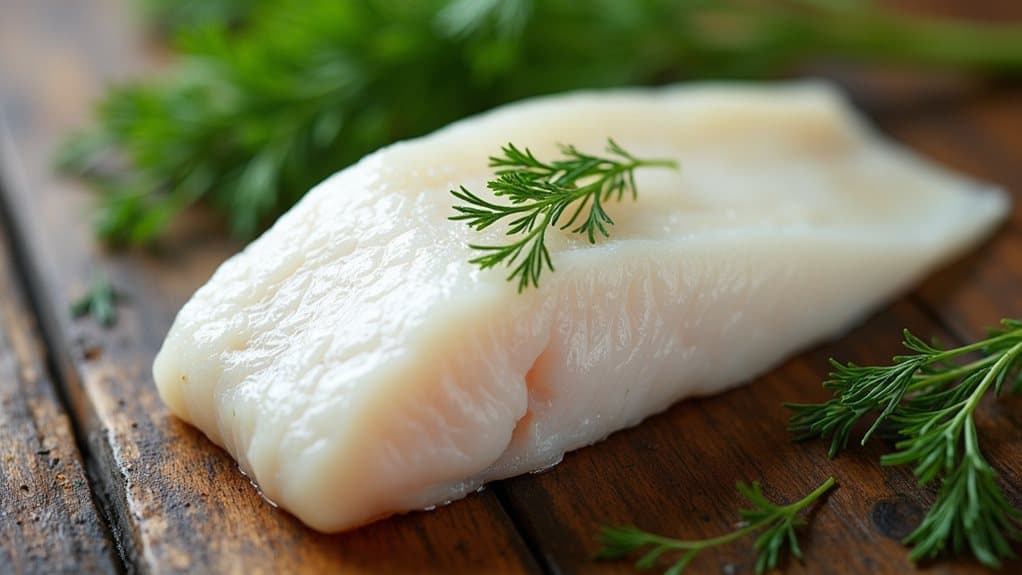
Largemouth bass offers a surprisingly versatile eating experience, characterized by white, flaky meat with a mild and delicate flavor that makes it appealing to a wide range of consumers. You’ll find the taste slightly sweet with low oil content, creating a tender, flaky texture that’s pleasant and accessible for those preferring less “fishy” freshwater fish options. The flavor can vary significantly based on geographical location and water conditions where the bass was caught. In fact, the taste can be influenced by the natural beauty of the environment where the fish thrives.
How Water Quality Affects Bass Taste
While largemouth bass naturally provides mild, delicate flavor, the environment where these fish spend their lives significantly impacts what ends up on your plate.
Clean, well-oxygenated water produces bass with superior taste, while polluted or stagnant waters introduce muddy, earthy off-flavors. Additionally, fish like bass thrive in clean, cold water, which helps enhance their flavor profile. Algae blooms and low oxygen levels create stress that compromises both flavor and texture quality. Research shows that water salinity can enhance the sweetness and umami compounds in bass flesh while reducing bitter flavors.
Seasonal Variations in Bass Flavor
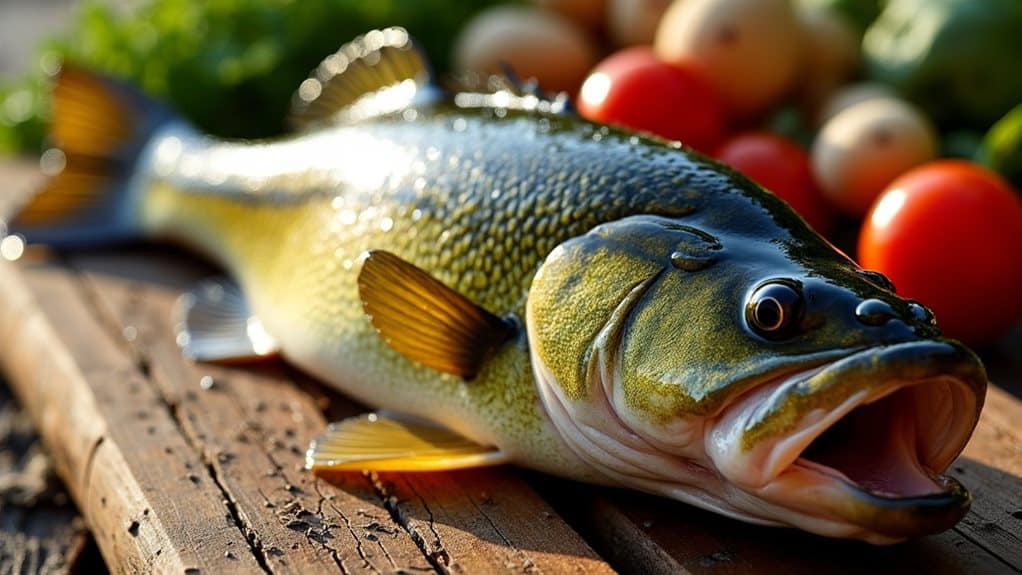
Just as water quality shapes the flavor of your catch, the season when you reel in that bass greatly affects what you’ll taste on your dinner plate.
Fall bass develop richer, fattier flesh as they prepare for winter, while winter fish become leaner with milder flavors. Spring spawning bass taste bland due to energy expenditure, but summer brings balanced, moderately flavorful meat. Additionally, the optimal fishing time during these seasons can impact the quality and flavor of the fish you catch.
Size Matters: Small Vs Large Bass Taste Differences
Why does a two-pound bass taste so different from its eight-pound cousin?
Smaller bass offer tender, milder flesh with delicate flakes, while larger bass develop firmer, sometimes tougher meat with stronger, earthier flavors. You’ll find small bass have leaner flesh and finer bones, making them easier to prepare and generally more appealing to most palates. This difference in texture and flavor can be attributed to the size matters in fish, as larger fish tend to have a more pronounced taste.
Largemouth Vs Smallmouth Bass Flavor Comparison
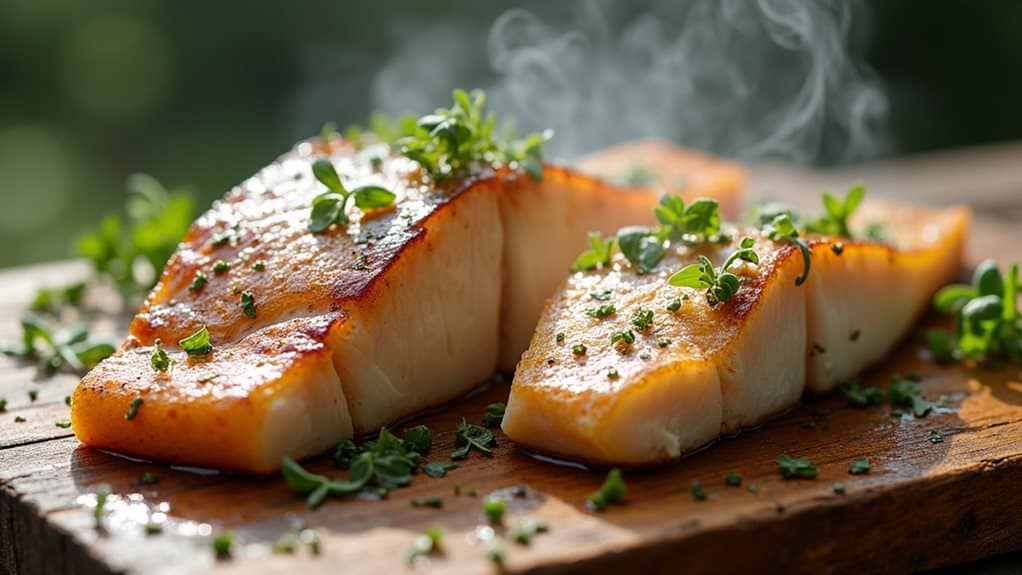
When you’re comparing largemouth and smallmouth bass on your dinner plate, you’ll find that both species offer surprisingly similar mild, slightly sweet flavor profiles that most anglers can’t distinguish in blind taste tests.
The real difference lies in texture, where smallmouth bass provides firmer, more consistent flesh while largemouth tends to be flakier and more delicate, similar to crappie.
While neither species dominates consumer preferences based on taste alone, smallmouth often edges ahead due to its reliable texture and the fact that smaller largemouth specimens generally taste better than their larger counterparts.
Taste Profile Differences
Although both largemouth and smallmouth bass share similar white flesh characteristics, their flavor profiles differ noticeably when you compare them side by side.
You’ll find largemouth bass has a mild but watery flavor that’s often fishier, while smallmouth bass offers a cleaner, sweeter taste that’s more delicate and appealing to most palates.
Texture and Firmness
The texture battle between largemouth and smallmouth bass reveals distinct differences that’ll influence your cooking decisions and dining experience.
Largemouth bass features coarser meat with larger flakes, while smallmouth offers finer, more delicate texture.
Smallmouth’s firmer consistency makes it ideal for grilling or pan-frying, whereas largemouth’s softer grain works better in stews or casseroles.
Consumer Preference Trends
Consumer preference trends between largemouth and smallmouth bass reveal a fascinating divide that’s built more on anecdotal evidence than scientific data.
You’ll find smallmouth often praised as “cleaner” and “sweeter” in fishing forums, while largemouth gets labeled “fishier.”
However, blind taste tests show mixed results, with many participants unable to distinguish meaningful differences between the species.
Preparing Bass for Optimal Taste
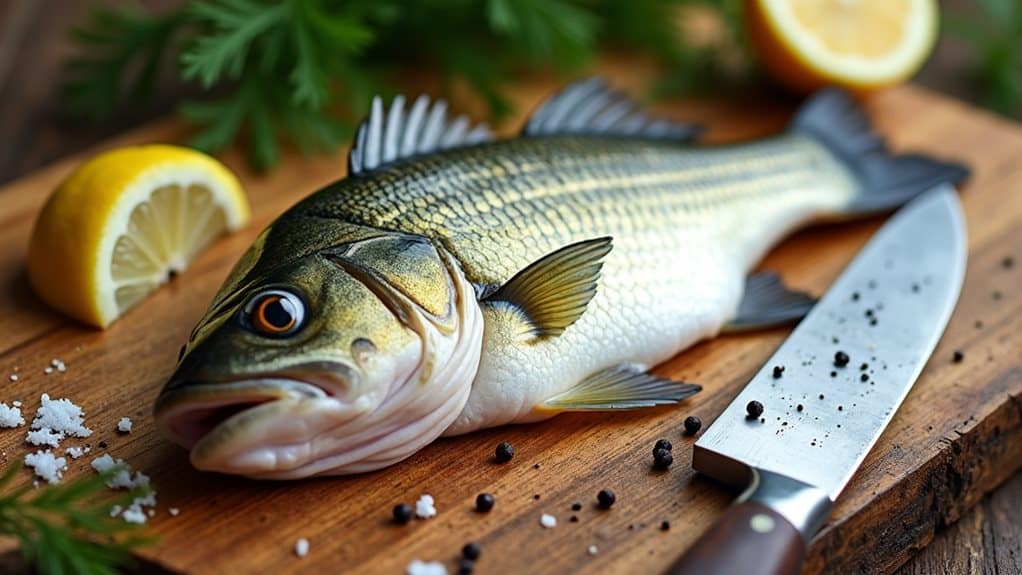
You’ll find that proper preparation is the key to changing largemouth bass from potentially fishy to deliciously mild.
The size of bass you choose, when you catch them, and how you clean them all play essential roles in determining the final taste on your plate.
Let’s examine how removing skin and bloodlines, selecting the right-sized fish, and timing your catch can dramatically improve your bass eating experience.
Remove Skin and Bloodlines
Two critical steps can dramatically improve your largemouth bass’s flavor: removing the skin and eliminating bloodlines.
Pour boiling water over the skin-side-up fillet, then use paper towels for better grip while peeling.
Cut out the dark bloodlines running along the spine area, as they’ll create bitter flavors.
Rinse fillets under cold water and pat dry before cooking.
Size Selection Matters
Beyond proper preparation techniques, selecting the right size bass makes a significant difference in your final dish’s quality and flavor.
You’ll find that 14 to 15-inch bass offer the best combination of tender, firm meat with mild flavor.
Smaller bass lack sufficient meat and may taste fishier, while larger specimens often develop coarser texture and stronger flavors that require different cooking methods.
Seasonal Timing Considerations
While selecting the right size bass sets the foundation for great taste, timing your catch according to seasonal patterns can enhance your meal from good to exceptional.
Spring and fall offer ideal conditions when water temperatures reach 65–80°F, keeping bass active and stress-free.
Winter fishing produces firmer meat in cold, clear rivers, while summer requires immediate icing to preserve quality.
Best Cooking Methods for Largemouth Bass
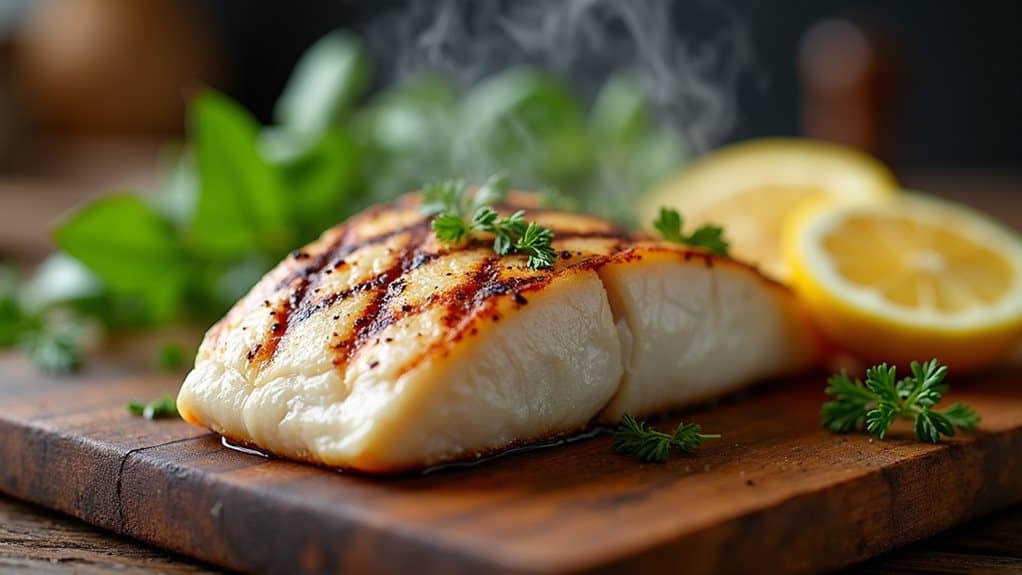
Since largemouth bass offers a mild, versatile flavor that adapts well to various preparation methods, you’ll find that choosing the right cooking technique can make all the difference in creating a memorable meal.
Pan-frying with flour coating delivers golden, crispy results, while grilling adds smoky depth.
Breading creates restaurant-style crunch, and baking preserves delicate textures beautifully.
Removing Fishy Flavors From Bass
Even the freshest largemouth bass can sometimes carry a fishy or gamey flavor that might put off diners who prefer milder-tasting fish.
You can neutralize these strong flavors through several effective methods. Soak fillets in milk for 30 minutes to four hours, allowing casein proteins to bind trimethylamine compounds that cause fishiness.
Salt-based marinades also draw out unwanted tastes effectively.
Why Some People Dislike Largemouth Bass
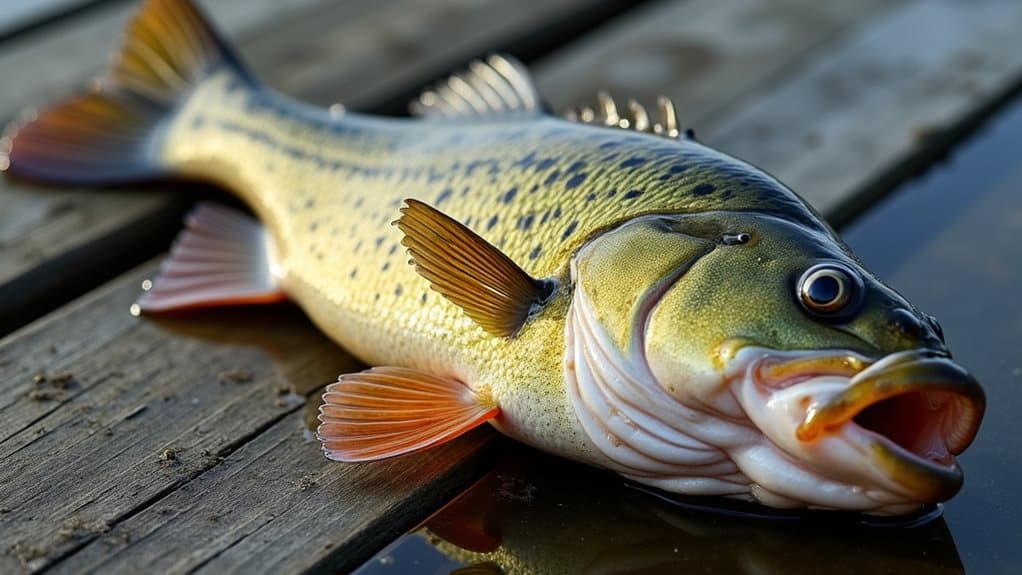
Despite largemouth bass being perfectly edible and nutritious, many anglers and diners avoid eating them for reasons that extend far beyond actual taste preferences.
Decades of catch-and-release campaigns have created cultural taboos against eating bass, with some anglers considering it almost religiously offensive.
Additionally, you’ll find that bass from murky, vegetated waters often develop stronger, muddier flavors than cleaner alternatives.
Safety Considerations When Eating Wild Bass
When you’re considering eating wild largemouth bass, you’ll need to evaluate several important safety factors that can affect your health.
The water quality where you caught your bass directly impacts the fish’s safety for consumption, as contaminated waterways can lead to mercury accumulation, PCBs, and other harmful chemicals in the fish tissue.
You should also assess potential parasite risks and understand how various pollutants concentrate in predator fish like largemouth bass, especially since larger, older fish typically contain higher contaminant levels.
Water Quality Concerns
While largemouth bass might taste delicious, the water they swim in can greatly impact both their health and your safety when you consume them.
Poor water quality from nutrient imbalances, oxygen depletion, mercury contamination, and harmful algal blooms can affect fish health and potentially compromise food safety, making it essential to contemplate your fishing location’s environmental conditions.
Parasite Risk Assessment
Beyond environmental concerns, wild largemouth bass can harbor parasites that pose health risks to humans who consume them.
Two trematode species, *H. pumilio* and *C. formosanus*, infect over 90% of bass in some regions, potentially causing gastrointestinal symptoms like diarrhea and weight loss.
You’ll eliminate these risks by cooking fish thoroughly or freezing at -4°F for one week.
Pollution and Contaminants
Although parasites present one concern for wild bass consumption, chemical contaminants pose a more persistent and potentially serious threat to your health.
Mercury bioaccumulates in largemouth bass tissue, with older, larger fish containing higher concentrations. This neurotoxin can cause cardiovascular and nervous system damage, particularly affecting pregnant women and children through developmental impairments.
Final Note
You’ll find largemouth bass offers a mild, sweet flavor when caught from clean waters and prepared properly. Remember that water quality, season, and size all impact taste greatly. If you’re new to eating bass, start with smaller fish from clear lakes, remove the skin and dark meat, and try simple preparations like pan-frying or baking. With proper handling and cooking techniques, you’ll uncover why many anglers consider largemouth bass excellent table fare.




